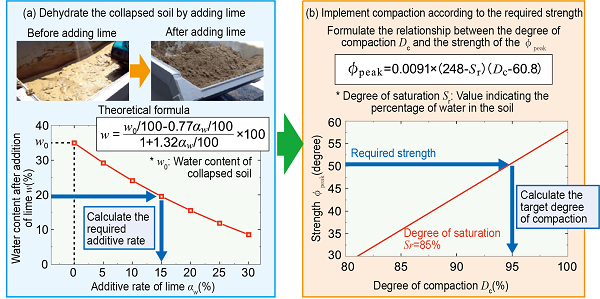9. Restoration techniques for embankments reusing collapsed soil
In recent years, there have been many cases where embankments are damaged by heavy rains, etc. When an embankment collapses due to heavy rain, it is difficult to compact the soil after the collapse again because it contains a large amount of water. In addition, since the materials used to construct the old embankments did not meet the current regulations in many cases, the soil needed to be purchased for restoration, which posed a problem in terms of construction period and cost. To address these issues, we have proposed a method of restoring embankments by adding lime to the soil collapsed due to heavy rains and compacting it for reuse.
This method utilizes (1) the dehydration effect of lime and (2) the increase in the soil strength due to compaction. As for (1), because only the dehydration effect is expected of the lime, an indoor mixing strength test is not necessary, and the required additive rate of lime can be easily calculated by substituting the water content of the soil after the addition of lime into the theoretical formula obtained from the chemical reaction formula of lime and water [Fig. 1(a)]. As for (2), after dehydration with lime, construction is carried out so that the degree of compaction becomes the target degree of compaction obtained from the required strength using the relational expression between the degree of compaction and strength [Fig. 1 (b)]. Since this formula reflects the increase in soil strength due to the increased degree of compaction, even if the collapsed soil is made of materials that do not meet the current regulations, it can be reused by increasing the degree of compaction.
With this method, the construction period and cost required for restoration of embankments after heavy rains and earthquakes can be reduced by about 10 to 20% compared to conventional methods. For a case where the embankment collapses due to an earthquake, the collapsed soil can be reused by using only the relational expression between the degree of compaction and strength shown in Fig. 1 (b).
Other Contents
- 9. Restoration techniques for embankments reusing collapsed soil
- 10. Structural performance evaluation of existing bridges by acceleration monitoring
- 11. Multi-point synchronous measurement system for railway bridge vibration using a video camera
- 12. Low-cost deterioration evaluation method for the backside ground of slope protection works
- 13. Boring method for constructing a crossing structure under railway tracks making it possible to shorten the construction period
- 14. Maintenance method for prestressed concrete sleepers according to the installation environment
- 15. Low-cost ballastless tracks for existing lines and roadbed improvement method
- 16. The image analysis engine for around track to support train patrol
- 17. Insulator contamination estimation method based on public data
- 18. Degradation evaluation method for lithium-ion batteries for vehicle control circuits
- 9. Restoration techniques for embankments reusing collapsed soil
- 10. Structural performance evaluation of existing bridges by acceleration monitoring
- 11. Multi-point synchronous measurement system for railway bridge vibration using a video camera
- 12. Low-cost deterioration evaluation method for the backside ground of slope protection works
- 13. Boring method for constructing a crossing structure under railway tracks making it possible to shorten the construction period
- 14. Maintenance method for prestressed concrete sleepers according to the installation environment
- 15. Low-cost ballastless tracks for existing lines and roadbed improvement method
- 16. The image analysis engine for around track to support train patrol
- 17. Insulator contamination estimation method based on public data
- 18. Degradation evaluation method for lithium-ion batteries for vehicle control circuits

